B.R. Bates's Blog: From the social feeds ...
September 9, 2025
Michigan History Author Symposium 2025 -- who's going?
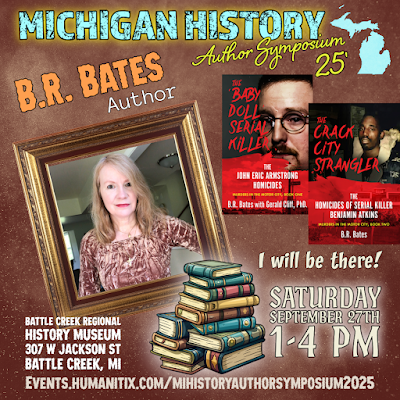
Hear from a variety of authors who will share slices of Michigan history — and say hello to this one, too! It all happens at the Battle Creek Regional History Museum on September 27.#author #book #event #booksigning #battlecreek #history 📕📗📘📙📚
September 5, 2025
#RememberThem: Margie, survivor
“I remember my mother saying that she used to look for me in the morgue, when the killings happened. But I never told her that I actually survived Atkins.”
Those are the words of a woman named Margie, who had a terrible encounter with Benjamin ("Tony") Atkins a year before any of his other known attacks. Can you believe that? The irony in those words? A mom worried about her daughter, knowing she's out there on the streets, and has been out there for a couple years at that point, where other females are being killed by a strangler?
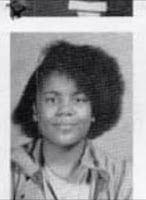 Margie as a teen,
Margie as a teen, about the time
she encountered
Atkins.
Margie was very young when she got hooked on drugs and started working prostitution along Woodward Ave in Detroit. She had seen Atkins around, saw him scoring drugs up by Seven Mile Road. And she was only 15 when he asked if she wanted to smoke some with her. What was a casual street thing turned violent -- he hit her and told her he was going to kill her. He turned into another person when he smoked the crack, Margie said. Like the devil himself. It was only her gift of gab -- and the offer to give him the money she had on her -- that saved her life.
And for years and years, she told no one the story. Because that's the way it is with women at risk on the streets. Is anybody going to believe you? Or care? Most females figure, no. Law enforcement doesn't care -- they only talk to you when they need some street intel.
Margie's story is one with some other crazy ironies. Atkins was not the only person who tried to kill her on the street, and maybe that's not surprising. These gals are involved in violent attacks quite a bit. But she actually knows someone who was the victim of another serial killer, a more recent one, DeAngelo Martin. He was suspected to have killed a friend of Margie's named Yvonne, when her body was discovered. Is it a small world, or are the streets of the Motor City (or any big city, truthfully) really that bad?
Margie is thinking about writing a book about her experiences. And I hope she will, because it will be a story of encouragement and determination.
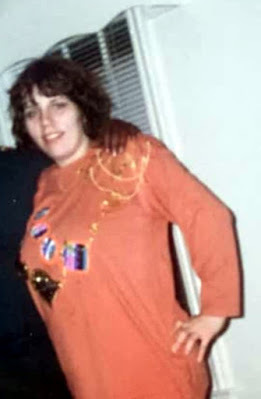 Yvonne, assumed victim of convicted serial DeAngelo Martin.
Yvonne, assumed victim of convicted serial DeAngelo Martin.This photo and one above courtesy of Margie, specifically for use for the book below. Any other use prohibited.This post is part of a series on this blog that I am calling #RememberThem, a chance to honor the women who encountered the two Detroit serial killers I have researched, John Eric Armstrong and Benjamin ("Tony") Atkins. In this continuing series, with installments dropping every week or so, we first learn more about the women Armstrong was known to have killed in Detroit, plus two of his survivors, then we turn to the women who encountered Atkins. Click on the "Honoring the Victims" label on the left to see all of the parts in the series. Also see the #RememberThem series on YouTube.. . . . . . . . . . . . . . . . . . . . . . . . . .

For a deep-dive of the Atkins case, see "The Crack City Strangler: The Homicides of Serial Killer Benjamin Atkins."
BRBates.com
wbp.bz/CrackCityStrangler
Murders in the Motor City Series
August 29, 2025
#RememberThem: Ocinena (CC)
Of all the victims in the case of convicted serial killer Benjamin Atkins, CC was the one that police actually didn't know about -- at least not until they had arrested their perp and had gotten him talking. Then he told them that there was a victim they had not found yet. He told them where to find her, and that day police discovered the body of Ocinena, nicknamed CC.
She was born in October 1969. She lived at Ford Street and Second Avenue in Highland Park, Michigan, west of Woodward, in the same block as her grandmother’s apartment on Manchester Parkway, This was also just a block or so from the address on record of another of Atkins' victims, Joanne, and a few blocks in the other direction from where yet another victim, Valerie, grew up. CC was single, apparently with no kids. She had a sister named Charee. CC's grandmother, Ruby, last saw her in May 1992 at Ruby’s apartment.
CC is one of the women we honor in the #RememberThem series. When Atkins assaulted her on the last day of May, she got a little piece of him in their scuffle -- he had to go to Detroit Receiving Hospital in the early morning hours of June 1 and get stitches. He gave the attending ER doctor some story about how he got the injury. But he hid CC well, in a garage off West Grand in Highland Park that reportedly had a double basement configuration. Nobody went down there. So nobody discovered CC for months. She became another one of Detroit's many missing females until the perp starting talking upon his arrest in August.
 A modern shot of Woodward Ave, with downtown Detroit in the distance. CC was the last one lured to her death by Benjamin Atkins along this historic thoroughfare.
A modern shot of Woodward Ave, with downtown Detroit in the distance. CC was the last one lured to her death by Benjamin Atkins along this historic thoroughfare. Photo by B.R. Bates; please do not copy without permission.
This post is part of a series on this blog that I am calling #RememberThem, a chance to honor the women who encountered the two Detroit serial killers I have researched, John Eric Armstrong and Benjamin ("Tony") Atkins. In this continuing series, with installments dropping every week or so, we first learn more about the women Armstrong was known to have killed in Detroit, plus two of his survivors, then we turn to the women who encountered Atkins. Click on the "Honoring the Victims" label on the left to see all of the parts in the series. Also see the #RememberThem series on YouTube.. . . . . . . . . . . . . . . . . . . . . . . . . .

Click on the "Honoring the Victims" label on the left to see all parts in this series.
For a deep-dive into the Atkins case, see The Crack City Strangler: The Homicides of Serial Killer Benjamin Atkins.
BRBates.com
wbp.bz/CrackCityStrangler
Murders in the Motor City Series
August 22, 2025
#RememberThem: Brenda
“Woman found dead of drug overdose,” read the small headline on the right rail of a newspaper page when Brenda was found inside an abandoned house on West Grand in Highland Park, Michigan, in April 1992. Her mom took exception to that. And yes, she was correct -- it was not a drug overdose, it was a cold-blooded killer.
Brenda was born in the early 1950s to Booker and Maggie M. She had an older brother, Fred, and an older sister, Dianne, as well as a younger brother, Frankie. They grew up on Detroit's east side, on Dean Avenue between Outer Drive and Eight Mile Road. Brenda graduated from Central High School. She seemed headed in the right direction, completing training to become a nurses’ aide. But soon after she moved out of the house at age nineteen, things started to go in another direction for Brenda.
Brenda's autopsy was later corrected to reflect her true cause of death. She is one of the women we honor in the #RememberThem series. Look for other posts on this same blog to learn more about each and every one of the women assaulted by Benjamin Atkins, because they were much more than names in a news report.
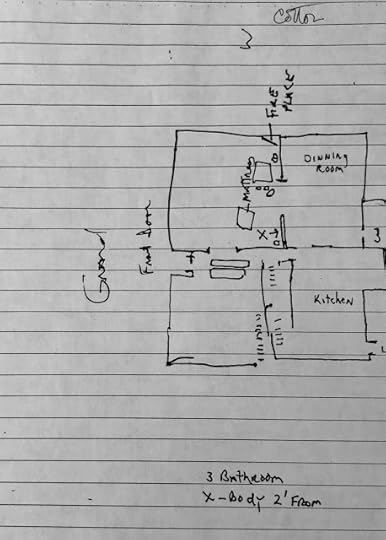 The police sketch from the scene where Brenda was found on West Grand. She was lying face down with a mattress and box spring on top of her.
The police sketch from the scene where Brenda was found on West Grand. She was lying face down with a mattress and box spring on top of her. This post is part of a series on this blog that I am calling #RememberThem, a chance to honor the women who encountered the two Detroit serial killers I have researched, John Eric Armstrong and Benjamin ("Tony") Atkins. In this continuing series, with installments dropping every week or so, we first learn more about the women Armstrong was known to have killed in Detroit, plus two of his survivors, then we turn to the women who encountered Atkins. Click on the "Honoring the Victims" label on the left to see all of the parts in the series. Also see the #RememberThem series on YouTube.. . . . . . . . . . . . . . . . . . . . . . . . . .

Above photo is a copyrighted image of a case file and specifically for use in The Crack City Strangler: The Homicides of Serial Killer Benjamin Atkins; any other use prohibited without permission.
BRBates.com
wbp.bz/CrackCityStrangler
Murders in the Motor City Series
August 19, 2025
You've got four autumn opportunities to come say hello to this author
Summer is so beautiful, and we're still in the thick of it, so who wants to think about fall? Well, that's when libraries plan a lot of their events, once their patrons have had their fill of the warm weather and vacation and all that, and once school gets back in session. There are four wonderful events on the horizon for me and an assortment of other great local authors. I will be attending these events with my collaborator, Dr. Gerald Cliff, and we'll be bringing both books in the #MurdersInTheMotorCity series, "The 'Baby Doll'' Serial Killer: The John Eric Armstrong Homicides" and "The Crack City Strangler: The Homicides of Serial Killer Benjamin Atkins."
 Wednesday, September 24, 20256 p.m.Timothy C. Hauenstein Reynolds Township LibraryHoward City, MichiganLearn more >>>.............................................
Wednesday, September 24, 20256 p.m.Timothy C. Hauenstein Reynolds Township LibraryHoward City, MichiganLearn more >>>.............................................
 Michigan History Author SymposiumSaturday, September 27, 20251-4 p.m.Battle Creek Regional History Museum307 W Jackson StBattle Creek, MichiganLearn more >>>.............................................
Michigan History Author SymposiumSaturday, September 27, 20251-4 p.m.Battle Creek Regional History Museum307 W Jackson StBattle Creek, MichiganLearn more >>>.............................................
 Sunday, November 2, 2025Starting at noonEllis Library & Reference Center3700 S. Custer Rd.Monroe, MichiganLearn more >>>
Sunday, November 2, 2025Starting at noonEllis Library & Reference Center3700 S. Custer Rd.Monroe, MichiganLearn more >>>.............................................

Saturday, November 15, 202511:30 a.m. - 1:30 p.m.Community Room - Brandon Township Public Library304 South StreetOrtonville, MichiganLearn more >>>
August 15, 2025
#RememberThem: Joanne
She was known by different names. Which was her real name? A lot of the time these women living at risk on the streets used different names.
Very little is known about her. We know she was born in August 1951. We know she had a sister named Katie in Muskegon Heights, on the west side of Michigan. We know she had a husband named James, who died before she did. She had an address on Ford Street near Woodward Avenue in Highland Park, a couple blocks north of the Davison Highway. That’s about it, however, because as with several other victims, no one could be reached to speak for her for this book. But still we honor Joanne as part of our Remember Them series.
Joanne was discovered in June 1992 in an empty three-unit commercial building on the west side of Woodward Ave between Cortland and Richton streets, in the storefront area of what was a suite of three rooms in the middle unit. The unit had once been a restaurant and a politician’s headquarters, as well as a church, and that's how her attacker remembered it, as a church. He knew this area; he was part of the landscape and blended right in, wandering from one abandoned building to another. Though Joanne was discovered in June, he killed her months earlier, when there was still snow on the ground.
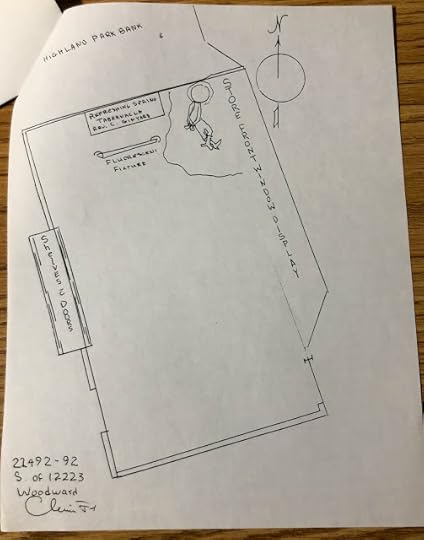 The sketch by Highland Park Public Safety from the scene where Joanne was discovered.
The sketch by Highland Park Public Safety from the scene where Joanne was discovered.This post is part of a series on this blog that I am calling #RememberThem, a chance to honor the women who encountered the two Detroit serial killers I have researched, John Eric Armstrong and Benjamin ("Tony") Atkins. In this continuing series, with installments dropping every week or so, we first learn more about the women Armstrong was known to have killed in Detroit, plus two of his survivors, then we turn to the women who encountered Atkins. Click on the "Honoring the Victims" label on the left to see all of the parts in the series. Also see the #RememberThem series on YouTube...........................................

Above photo is a copyrighted image of a case file and specifically for use in The Crack City Strangler: The Homicides of Serial Killer Benjamin Atkins; any other use prohibited without permission.
BRBates.com
wbp.bz/CrackCityStrangler
Murders in the Motor City Series
August 8, 2025
#RememberThem: Vicki Marie Robinson Beasley Brown -- a special tribute from her sister Denise
I can already tell you that this will be the most powerful post on this blog, because it comes directly from a family member. I am very thankful to be able to give you this firsthand portrait of Vicki Beasley Brown from her sister, Denise. Vicki had such an impact on her family that Denise's daughter went on to become a medical examiner, from her desire to help solve criminal cases like the one that claimed her aunt.
.....................
A Special WomanVicki was a miracle baby. She was born at seven months, weighed three pounds and two ounces and was delivered at home by our Great Great Aunt Mozelle Perry, a midwife from Sylacauga, Talladega, Alabama.
Our parents were Verlyn Randolph “Ran” Robinson and Gloria Anita Lipscomb Anderson. Lynne is the oldest, Vicki the middle child and I am the youngest daughter.
We lived at 9586 Cardoni Street near the Dodge Main auto plant where our Great Grandfather Henry Arthur Savage worked for over 40 years. Our family lived downstairs, our Great Grandpa and Great Grandma Annie lived upstairs, our maternal Grandparents Magnolia and George Webb lived a few blocks away and our widowed paternal Grandmother Rosa lived on the Westside.
At one end of our block was our school, Maybee Elementary, and at the other end was St. George Lithuanian Catholic School at 1313 Westminister, which we attended for a year. We lived on the border of Hamtramck.
Vicki was a mischievous girl with a beautiful smile. She would pick up a worm or a bug and chase me nearly every day, but if I was playing and hurt myself, she was the first one to comfort me.
We played in the front of the house with our neighbors the Black sisters and our “play”cousin Sherrand Burton until the street lights came on signaling dinner time.
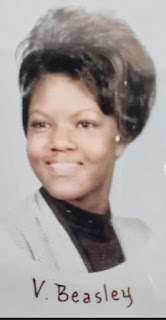 Vicki in eighth grade.We made mud pies, played hide and seek and during the day, our Great Grandmother gave us Mason jars to catch butterflies in the flower filled lot behind us. We competed to see who could catch the most butterflies and we always set them free afterwards.
Vicki in eighth grade.We made mud pies, played hide and seek and during the day, our Great Grandmother gave us Mason jars to catch butterflies in the flower filled lot behind us. We competed to see who could catch the most butterflies and we always set them free afterwards.Our community was vibrant and successful. Everyone looked out for one another. The only time we bought anything outside our community was on Saturdays when we went to the Eastern Market and when we went downtown to Hudson’s Department Store twice a year for school shoes.
Our Dad died of a heart attack when he was 32 and I was 3. Two years later our widowed 27-year-old Mom met a returning disabled Korean veteran who was a jazz pianist and she remarried. Our stepfather Clarence adopted us and changed our last name to Beasley.
Although there were lots of gigs in Detroit (especially at the famous Blue Bird on Tireman Street) he was drawn to New York. Mom was hired as a backup singer for people like our godmother Della Reese. We stayed behind for about three months until Mom returned to fly us to New York to live.
Our home was on 90th street between Columbus Avenue and Central Park so the park was our playground before Madonna claimed it. We all excelled in school and loved our new home. Our Detroit family sent monthly goodies by Railway Express and money. Vicki always spent all of hers on candy.
There were always musicians and vocalists at our home. Our godfather Billy Mitchell, John Coltrane, Dizzy Gillespie, Barry Harris, Hank, Thad and Elvin Jones, Dinah Washington and others. We were surrounded by music and spoiled!
When it became too difficult financially to keep us, our Great Grandmother and Grandmother came to take us back to Detroit. Although Mom called us every week, we didn’t see her again for four years. During that time Great Grandpa retired and received a gold watch. He died shortly afterwards. Great Grandma didn’t know how to get his pension, so our finances were greatly reduced.
When our parents returned to Detroit, we met our one-year-old brother. The next year, another brother was born. We soon began to feel that we were not important to our stepfather. Vicki and Lynne were both molested by a family member and life became harder. They both left home and moved in with our Great Grandmother and now widowed Grandmother.
Vicki initially was interested in nursing. She was a volunteer candy striper at a local hospital in her junior and senior years at Northwestern High. She was a petite doll and was named one of the seven prettiest girls of her senior class.
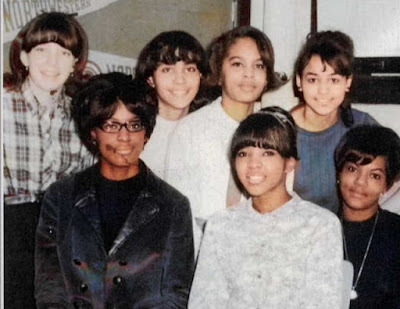 Vicki, far right, was voted one of the seven prettiest gals in her senior class. Another, far left, is author and playwright Pearl Cleage. Below, Vicki's senior class photo.
Vicki, far right, was voted one of the seven prettiest gals in her senior class. Another, far left, is author and playwright Pearl Cleage. Below, Vicki's senior class photo.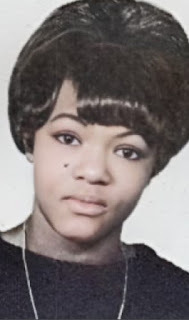 Vicki was an extremely talented artist and participated in a few citywide art shows. She was sought out by a Detroit art school while a senior but it was not a full scholarship so when she graduated, she started working at a Northland restaurant, where she met George “Lucky” Doucet. They had a daughter in 1967. Unfortunately, Lucky introduced Vicki to drugs, but she left him and was able to break that addiction at a rehab facility in California. Lucky was later killed in a robbery.
Vicki was an extremely talented artist and participated in a few citywide art shows. She was sought out by a Detroit art school while a senior but it was not a full scholarship so when she graduated, she started working at a Northland restaurant, where she met George “Lucky” Doucet. They had a daughter in 1967. Unfortunately, Lucky introduced Vicki to drugs, but she left him and was able to break that addiction at a rehab facility in California. Lucky was later killed in a robbery.Vicki met Willie Rankin and they had a son. Willie worked at General Motors. They were together for about seven years. (He died of esophagus cancer two months before Vicki was murdered.)
Vicki later worked at a small manufacturing plant where she met Monroe Stanford. They had two daughters and were together for about three years. During this time, Vicki had a ectopic pregnancy and her fallopian tube ruptured. She almost died and had emergency surgery. The resulting spasms led her to take Carisoprodol (Soma), a prescription muscle relaxant, along with pain medication. She was never a “crack head.”
Vicki and Jerome Brown were married on July 6, 1989, a week before her 41st birthday. He had loved her since they first became friends in 1974. Monroe Stanford and Jerome Brown both died a few years ago.
I spoke with Vicki two days before she was missing. I tried calling her back the next night but the phone line was constantly busy. I found out after she was murdered that she went to buy cigarettes that night and took the phone off the hook so her young daughters wouldn’t wake up and so she wouldn’t disturb her older “play” Grandmother where they were staying temporarily.
My sister was a bright light in a sometimes dark world. She was funny, compassionate, trusting, and talented. She loved family and took care of her children the best she could with a sometimes limited income. She didn’t eat until they did. She kept them well-groomed and clean even if she had to wash their clothes by hand.
We all miss her and will love her forever.
Denise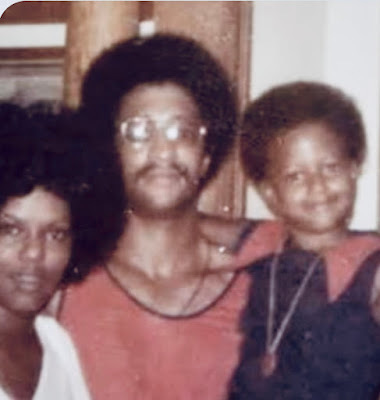 Vicki, George Pierre Doucet and their daughter Renee at Vicki's parents' home in Detroit.
Vicki, George Pierre Doucet and their daughter Renee at Vicki's parents' home in Detroit.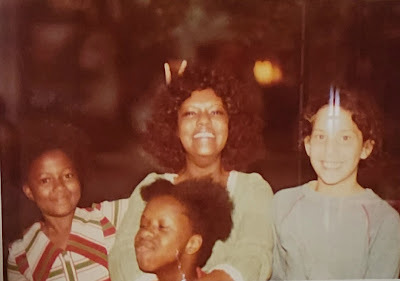

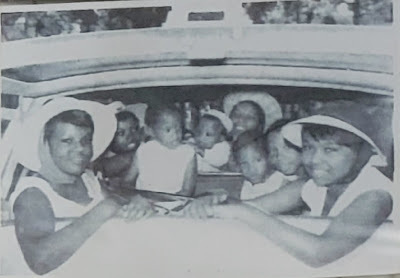 Vicki and her family in her younger years.
Vicki and her family in her younger years.This post is part of a series on this blog that I am calling #RememberThem, a chance to honor the women who encountered the two Detroit serial killers I have researched, John Eric Armstrong and Benjamin ("Tony") Atkins. In this continuing series, with installments dropping every week or so, we first learn more about the women Armstrong was known to have killed in Detroit, plus two of his survivors, then we turn to the women who encountered Atkins. Click on the "Honoring the Victims" label on the left to see all of the parts in the series. Also see the #RememberThem series on YouTube.. . . . . . . . . . . . . . . . . . . . . . . . . .
Photos courtesy of Vicki's sister Denise and daughter Renee and for use specifically on this blog and in The Crack City Strangler: The Homicides of Serial Killer Benjamin Atkins; any other use prohibited without permission.
August 7, 2025
Murder Shelf Book Club takes on "The Crack City Strangler" in fresh interview, just dropped
She says I'm one of her favorite authors -- well, she's definitely one of my favorite podcasters. Jill of the Murder Shelf Book Club has just dropped our interview on the "Crack City Strangler" book and the Benjamin ("Tony") Atkins case. Who was "Tony," and how did he key into Atkins' crimes? We delve into this serial killer's M.O. -- the pattern he followed on a daily basis that involved drugs, prostitution, and most definitely murder. Was there a split personality going on with him? An alternate personality? Just voices he was hearing? And what about the "mommy issues" that are evident with a lot of serials? Jill and I get into the more psychological aspects of this killer, and she has some interesting insight.

You can listen on Apple, Spotify, Castbox and other popular podcast platforms, and it will be dropping on YouTube, as well.
August 1, 2025
#RememberThem: Fifteen
In the decades since the arrest of serial killer Benjamin Atkins, there has always been one Jane Doe among the 11 women who lost their lives. Then in 2023, a cold-case investigative group based on the West Coast announced that they identified this Jane Doe via forensic genetic genealogy, working with a detective in Michigan, but said the family did not want her name to be released. I verified that for this book with phone calls to local law enforcement.
And there were a lot of possible IDs for this Jane Doe, at the time, but none of them panned out as far as fingerprints, dental records, etc. So even though the public still does not know the name of this victim, who was one of three women found on the same day at the Monterey Motel in Highland Park, Michigan, in February 1992, her family does have closure, and does know what happened to their loved one. For everyone else, she -- at least for right now -- remains UF 15 for 1992 in Wayne County, Michigan. I like to think of her as Fifteen, kinda like Seven of Nine on "Star Trek: Voyager" or Eleven on "Stranger Things." But not quite.
So we honor her with this installment in the #RememberThem series.
 A screenshot from the Monterey Motel crime scene video of the room where Fifteen was found. Atkins had told police how he placed mattresses in the doorway to the bathroom of Room 18 at the motel so that anyone wandering through the abandoned structure would be dissuaded from entering.
A screenshot from the Monterey Motel crime scene video of the room where Fifteen was found. Atkins had told police how he placed mattresses in the doorway to the bathroom of Room 18 at the motel so that anyone wandering through the abandoned structure would be dissuaded from entering.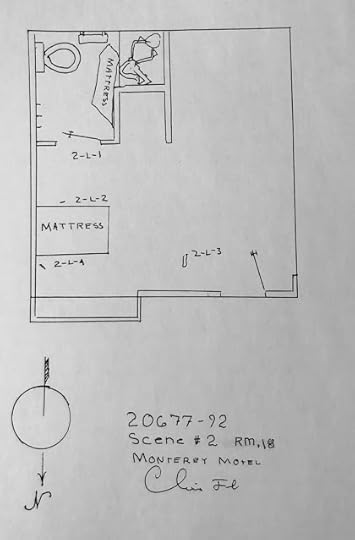
This post is part of a series on this blog that I am calling #RememberThem, a chance to honor the women who encountered the two Detroit serial killers I have researched, John Eric Armstrong and Benjamin ("Tony") Atkins. In this continuing series, with installments dropping every week or so, we first learn more about the women Armstrong was known to have killed in Detroit, plus two of his survivors, then we turn to the women who encountered Atkins. Click on the "Honoring the Victims" label on the left to see all of the parts in the series. Also see the #RememberThem series on YouTube.. . . . . . . . . . . . . . . . . . . . . . . . . .

Above photos are copyrighted and specifically for use in The Crack City Strangler: The Homicides of Serial Killer Benjamin Atkins; any other use prohibited without permission.
BRBates.com
wbp.bz/CrackCityStrangler
Murders in the Motor City Series
July 29, 2025
Killer Comparisons: Benjamin ("Tony") Atkins and Derrick Todd Lee
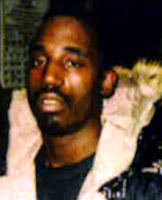 Benjamin Atkins, above,
Benjamin Atkins, above,and Derrick Todd Lee,
below. See copyright
notes below.
They were both young black men, born the same year -- just a couple months apart, actually. They both raped and beat their victims, targeting women and leaving DNA at the crime scenes. Their cases both crossed jurisdictional lines with the police agencies that were investigating them, and those agencies didn't realize at first that they were working the same case. Both men died with health issues while in prison. But how else do these two serials -- Benjamin ("Tony") Atkins and Derrick Todd Lee -- share traits, or differ?
Well, let's look at victimology. Though they both hunted women -- one in Louisiana and one in Michigan -- these killers chose quite-different types. Atkins was said to be killing his mother over and over, choosing a particular type similar to his heroin-addicted prostitute mother. Lee, on the other hand, chose a variety of females, a mix of ethnicities who all tended to be successful, pretty, independent -- not living at risk on the street. And Lee did not hunt on foot like the homeless Atkins -- he drove around a pickup truck. Though Lee had trouble with the law at an early age, caught peeping at women in their homes, he evidently began killing a bit later than Atkins, in the latter 1990s as compared to 1991 (though Lee was suspected to have killed one woman in 1992). Lee varied his methods, sometimes strangling like Atkins but often stabbing. In the hunt for Lee, police were thrown off at first, pursuing a white man until DNA testing showed them their unsub was black. In Atkins' case, police profiled him as a black man throughout the investigation.
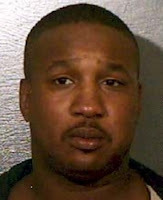
Besides having voyeurism in his background, Lee was suspected to have an abusive childhood, a trait he shares with Atkins. And both killers show one of the traditionally accepted markers of the Macdonald triad in childhood: Lee was known to abuse animals, and Atkins set fires. Both of these killers were assessed to have a lower IQ -- Lee perhaps a tad lower than Atkins. But both of these men had a nonthreatening demeanor, enabling Lee to knock on the doors of women asking for help and to be trusted by those women, while Atkins was able to lure females off to dark corners to smoke crack without a problem (the fact that his victims were drug-addicted unfortunately helped). Both of these men were said to present themselves in a way that put people at ease. Atkins was, after all, described by at least one cop who worked his case as "Gentle Ben."
At the same time, from a psychological standpoint, both of these killers were assessed as having compulsive behavior, as not being able to control their impulses (yeah, maybe you can insert a "duh!" here). Lee reportedly had complaints of battering on record from not only his wife, but his girlfriend and sister, as well. Atkins did not have any reports of battering the individuals close to him, but those who knew him or knew of him (including at least one of his assault survivors) said he became a different person when he smoked crack. He seemed demonic. For both of these men, there was a noted psychological effect on sexuality emerging from childhood. Their sense of sexuality or sexual behavior was altered at a young age. For Lee, it was termed "hypersexuality" in adolescence; for Atkins, it was evidently stemming from sexual abuse -- he claimed abuse by a staff member at the home for boys where he lived for two years, as well as at the hand of one of his mother's boyfriends. Details are murky, but whatever happened as they were growing up, their views of sexuality were obviously not healthy ones.
Certain life events can serve as triggers for serials. Job loss often comes up as one of them. This has been theorized as a trigger for both of these killers, though in my research of the Atkins case I tend to doubt that losing his job at the pizza place actually caused him to start killing people. I think it was another, much stronger, event.
While Atkins got multiple life sentences for killing 11 women and assaulting one other who survived, earning him multiples of Michigan's mandatory life sentence for first-degree murder, Lee received Louisiana's death penalty after being tried for two of his seven kills but died before he could be executed.
Above photos:
- Derrick Todd Lee, 34, is shown in this photo released by the police. http://crime.about.com/od/serial/ig/serialkillerphotos/lee_derrick_t.htm, fair use, https://en.wikipedia.org/w/index.php?curid=20031894.
- Benjamin Atkins, from Detroit Police files, image obtained by FOIA. See this blog post for more on this photo and the confusion over photos of Atkins.
. . . . . . . . . . . . . . . . . . . . . . . . . .

For more on the Derrick Todd Lee case, see S2E1 of "Making a Serial Killer." For a deep-dive of the Atkins case, see "The Crack City Strangler: The Homicides of Serial Killer Benjamin Atkins."
BRBates.com
wbp.bz/CrackCityStrangler
Murders in the Motor City Series
From the social feeds ...
- B.R. Bates's profile
- 8 followers



